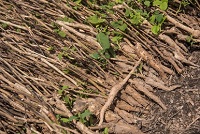Studies on antitussive effect of Tectona grandis roots using a cough model induced by sulfur dioxide gas in guinea pigs
Keywords:
Antitussive, Tectona grandis, Rhizomes and Methanol extractAbstract
Objectives: Anti-tussive drugs are among the most widely used medications world wide; however no new class of drugs has been introduced into the market by keeping this point in mind. This attempt is made by testing a root of a well known timber tree Tectona grandis. Materials and methods: Here in, we have analyzed the polar compounds of Tectona grandis roots using chemical and biological methods. In this study, in vivo antitussive activity of root extracts (methanol and water) of Tectona grandis Linn. f. (Verbenaceae) was evaluated using a cough model induced by sulfur dioxide gas in rats. Results and Discussion: Treatment with aqueous extract and methanol extract at 500 mg/kg p.o. dose level showed more anti-tussive effect as compared with the dose level of 250mg/kg p.o. Differences between means were assessed by one way analysis of variance (ANOVA),followed by Dunnett’s test using sigma stat software. Both the extracts (methanol and water) significantly (P<0.05) suppressed the asthmas at the dose level of 500mg/kg.Phytochemical tests showed that methanol and water extracts tested positive for carbohydrates, reducing sugars, alkaloids, glycosides, flavonoids, sterols and saponins. Conclusion: This study provides a scientific basis on ethno medical uses of this plant. Further exploration in drug development of antitussives from Tectona grandis can focus on the purity activity relationships (PAR studies).
References
Reynolds SM; Mackenzie AJ; Spina D;
Page CP. The pharmacology of cough,
Trends Pharmacol. Sci. 2004;25:569-576.
Richard S, Irwin MDJ, Mark Madison
MD, Armando E and Fraire MD. The
cough reflex and its relation to gastro
esophageal reflux, Am. J. Med.
;108:73S-78S
Stone RA, Barnes PJ and Fuller RW.
Contrasting effects of prostaglandin E2
and F2 on sensitivity of the human cough
reflex. J. Appl. Physiol. 1992;73:649-653.
O’Connell F, Springall DR, MoradoghliHaftvani A,Krausz T, Price D and Fuller
RW. Abnormal intraepithelial airway
nerves in persistent unexplained cough.
Am. J. Respir. Crit. Care Med.
;152:2068-75.
Massoud M., Jalipour H and salehian P.
Toxicity of Pegamum harmala review and
a case report. Iran J. of Pharmacol.
Therao. 2002;1:1-4.
Braga PC, Allegra L. Cough. Raven
Press, New York 1991.
Agharakar SP. Medicinal Plants of
Bombay Presidency. Pbl. Scientific
Publishers, Jodhpur, India. 1991;208-209.
Goel RK, Pathak NK, Biswas M, Pandey
VB, Sanyal AK. Effect of lapachol, a
naphthaquinone isolated from T. Grandis,
on experimental peptic ulcer and gastric
secretion. J. Pharm. Pharmacol.
;39(2):138-140.
Miyagoshi M, Amagaya S, Ogihora Y.
Antitussive effects of L- ephidrine
amygdaline and makyokanse kito
(Chinese traditional medicine) using a
cough model induced by sulfur dioxide
gas in mice, Planta. Med. 1986:52:275.
Yan-Tong Xu, Pang-Chui Shaw, RenWang Jiang, Po-Ming Hon Yiu-Man
Chan, Paul Pui-Hay But. Antitussive and
central respiratory depressant effects of
Stemona tuberose, Journal of
Ethnopharmacology. 2010;128:679–684.



